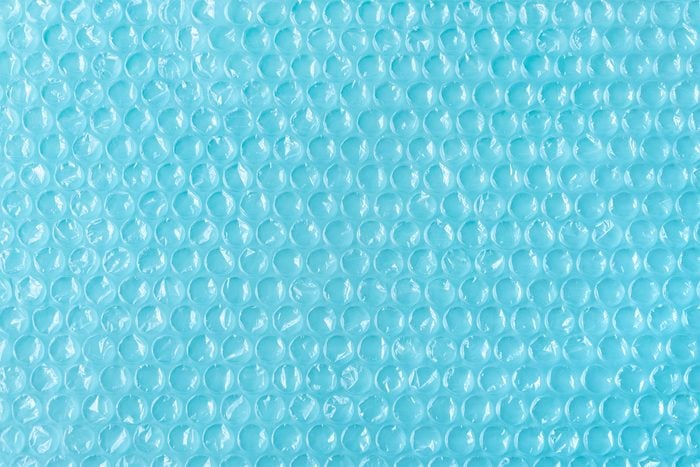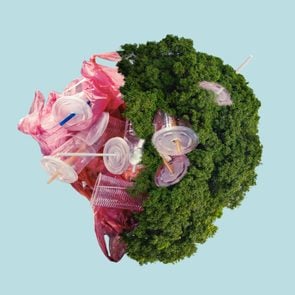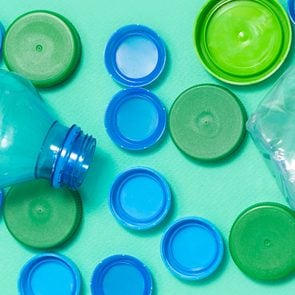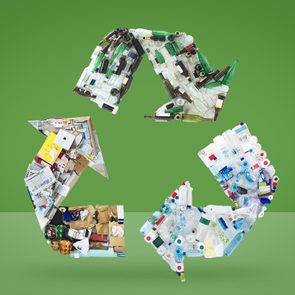Is Bubble Wrap Recyclable? How to Handle This Popular Packing Material
Updated: Apr. 14, 2024

Don’t throw bubble wrap into your regular recycling bin! Here’s what you need to know about this type of plastic to keep it out of a landfill.
Admit it: You loved popping bubble wrap as a kid—and still do as an adult. There’s something weirdly satisfying about it, not to mention stress-relieving. Plus, this ubiquitous packing material is incredibly useful, protecting delicate items when we’re shipping them or packing them up to move. But bubble wrap is actually a major stressor on our environment, much like other plastic products, from water bottles to Styrofoam.
Research from the EPA reveals that in 2018, 4.2 million tons of plastic bags, sacks and wraps (under which bubble wrap is classified) were produced, and of that number, a whopping 3.04 million tons ended up in landfills. And according to additional data from the Recycling Partnership, just 2% of film and flexible packaging materials are recycled annually. So, what can you do to help, aside from trying to avoid this packing material? Is bubble wrap recyclable?
The short answer is yes, bubble wrap is recyclable. (And just FYI, while there are a few things you can’t recycle, most items can be recycled.) But you need to know how to recycle bubble wrap, since it can’t simply be thrown in with the rest of your recyclables for curbside pickup.
Here, we delve into exactly what you need to know about this poppable material—from what it’s made of, exactly, to what you need to know about recycling or repurposing it to lead a more sustainable life and reduce your carbon footprint. Believe it or not, you can use bubble wrap in many ways you’d never expect!
What is bubble wrap?
Bubble wrap, of course, is a sheet of plastic with air bubbles. A packing material, it’s commonly used to protect or safeguard items being moved from one place to another. For example, you might wrap it around breakable items when you’re moving or sending a gift (think vases, dishes, collectibles and whatever else), and you’ll likely find it surrounding everything from those delicate items to electronics when you buy them at a store. But it also pops up (so to speak) in some envelopes.
Katzke Packaging Co. explains that “bubble wrap is made from tiny beads of resin with different properties … [which] is then combined and melted to form a thin film.” That film is then fed through rollers with small holes that create the air bubbles and ultimately sealed with another layer of film. It’s then rolled into large rolls for consumers to purchase. Of course, when it’s being made, it can be customized by thickness, length, perforations, bubble size and color.
Is bubble wrap recyclable?
As noted above, the answer is yes, you can recycle bubble wrap. But it can’t be placed on your curb for pickup or brought to your regular recycling center for drop-off. That type of recycling is reserved for harder plastics, such as milk containers, water and soda bottles, shampoo bottles, detergent bottles and the like. Made from polyethylene terephthalate (PET) or high-density polyethylene (HDPE), harder plastics are classified as Resin Identification Codes (RICs) 1 and 2 in the recycling world, and they’re what the majority of recycling machines were built to handle.
Bubble wrap, on the other hand, is made of a low-density polyethylene (LDPE), which is classified under RIC #4. This category comprises plastic films, which also include plastic bags and wraps, including shrink wrap. Here’s a handy guide to what those plastic recycling numbers mean. (And yes, you should be paying close attention to them!)
Why is bubble wrap difficult to recycle?
The main issue is that bubble wrap and other plastic films can clog recycling machines. This, of course, stops the recycling process until the machine gets fixed, which costs time and money. Workers may also sometimes get hurt while trying to clear the jam.
There’s also the issue of contamination. This is a fancy way of saying that all recyclables need to be kept separate. Even if an item is recyclable, if it ends up in the wrong recycling bin, it might get rejected at the recycling plant. When that happens, it will end up at a landfill, thus making it not recyclable, after all. So, make sure to separate out that bubble wrap from your other plastic recyclables, and if you have a combo item, like a bubble-wrap-lined envelope, break it down into its parts (bubble wrap and paper) and recycle each accordingly.
How do you recycle bubble wrap?
Now you know the answer to the question “Is bubble wrap recyclable?” But you still need to know how to recycle it, and that entails locating a recycling center that deals specifically with this type of plastic. While it’s an extra step you’ll need to take, you can easily incorporate it into your recycling routine once you have the right information. Even easier? Reusing bubble wrap for various projects around your own home.
Where can bubble wrap be recycled?
To find a recycling center near you that accepts bubble wrap, search Bag and Film Recycling’s Drop-Off Directory. Just plug in your zip code, and a list of nearby centers will pop up, at places like Target, Walmart and local grocery stores. You can also use the Recycling Center Search, powered by Earth 911, to find bubble wrap recycling centers—as well as spots for other tricky recyclables.
Once at the recycling center, a machine will break down the bubble wrap into tiny pieces and eventually turn them into pellets. Those recycled plastic pellets can be used to make a variety of plastic items, from furniture to flooring to construction materials.
How can you repurpose bubble wrap?
If you still want to use bubble wrap—or use up the bubble wrap you already have on hand—a good rule of thumb for reducing waste and consumption is to reuse it as many times as you can. So, after it’s served its main purpose, stash it away in the attic or a closet, and bide your time until the next time you need it. (Trust us, you will!) You can also give it to friends who are moving, or offer it for free on sites like Craigslist, FreeCycle or Facebook.
Upcycling is also a smart option for bubble wrap. With upcycling, your bubble wrap will get a new life as something else that’s equally handy. For example, you can use it in gardening to insulate plants in containers when the weather turns chilly or to protect delicate blooms from frost. It also helps to keep hot food hot and cold food cold, as well as insulate drafty windows (ideally ones that are out of sight) and outdoor doghouses and treehouses.
And if you have kids, there are loads of art and sensory activities you can try with bubble wrap, from “stomp painting” to making creative painted cards with—you guessed it!—bubble-like motifs. The only limit is your imagination.
The downside to bubble wrap
Bubble wrap may be recyclable, but it’s not biodegradable. In fact, according to Green Citizen, it could take anywhere from 10 to 1,000 years to fully decompose in a landfill. Yes, you read that right—up to 1,000 years for a single sheet of bubble wrap. Once in that landfill, this plastic material can release toxic chemicals into the ground and water supply, potentially harming animals and humans. If it is burned in an incinerator, chemicals like dioxin will enter the air as well. Both situations increase pollution and greenhouse gas emissions—including methane and ethylene—and accelerate climate change. And that’s even if the bubble wrap makes it to a landfill, as opposed to littering the land, the ocean and other waterways.
And in addition to the environmental considerations, there are a few personal ones as well. Bubble wrap can take up a good deal of storage space, and when you do use it for something like moving, you tend to need a lot of it. Those costs, of course, add up quickly.
What are some alternative packaging materials to bubble wrap?
Luckily, bubble wrap isn’t your only option when you need something to protect your valuables. Eco-friendly companies are now offering a variety of innovative, alternative packaging materials that are environmentally friendly and biodegradable.
Ranpak, for example, creates a honeycomb cushion wrap that is durable, protective and 100% curbside recyclable, since it’s made of paper. Plus, you don’t even need a scissor to cut it or tape to wrap up your item when using it. There are also cornstarch-based packing materials that look just like Styrofoam peanuts but are nontoxic and compostable, as well as mushroom packaging, which will decompose in about 30 days. And don’t forget about repurposed newspapers, kitchen towels and old shirts. Talk about an easy and economical solution to your packing problems!
That’s a wrap!
While bubble wrap may not be your most eco-friendly choice when it comes to packing materials, it is recyclable if you choose to use it or if it comes with an item delivered to your doorstep. Just make sure to take the steps to recycle it properly, or use it in another clever way. Speaking of upcycling, check out our article on how to upcycle clothes to create unique, environmentally friendly pieces. The earth—and your wardrobe—will thank you!
Sources:
- Environmental Protection Agency: “Frequent Questions Regarding EPA’s Facts and Figures About Materials, Waste and Recycling”
- Recycling Partnership: “Addressing the Challenge of Film and Flexible Packaging Data for The Recycling Partnership’s Film and Flexibles Coalition”
- Katzke Packaging Co.: “How It’s Made: Bubble Wrap”
- Almanac: “Which Plastics Are Recyclable by Number?”
- Rubicon: “What Is Recycling Contamination, and Why Does It Matter?”
- Green Citizen: “A Definitive Guide to Recycle Bubble Wrap”
- Business Waste: “Bubble Wrap Disposal and Recycling”



